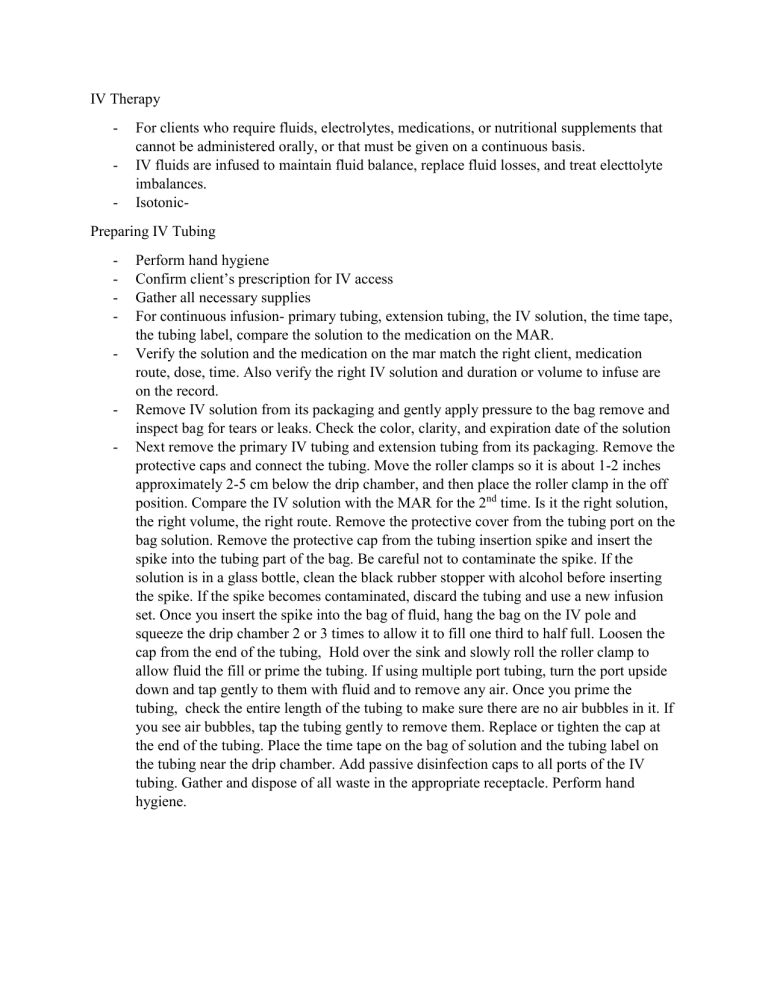
IV Therapy - For clients who require fluids, electrolytes, medications, or nutritional supplements that cannot be administered orally, or that must be given on a continuous basis. IV fluids are infused to maintain fluid balance, replace fluid losses, and treat electtolyte imbalances. Isotonic- Preparing IV Tubing - - Perform hand hygiene Confirm client’s prescription for IV access Gather all necessary supplies For continuous infusion- primary tubing, extension tubing, the IV solution, the time tape, the tubing label, compare the solution to the medication on the MAR. Verify the solution and the medication on the mar match the right client, medication route, dose, time. Also verify the right IV solution and duration or volume to infuse are on the record. Remove IV solution from its packaging and gently apply pressure to the bag remove and inspect bag for tears or leaks. Check the color, clarity, and expiration date of the solution Next remove the primary IV tubing and extension tubing from its packaging. Remove the protective caps and connect the tubing. Move the roller clamps so it is about 1-2 inches approximately 2-5 cm below the drip chamber, and then place the roller clamp in the off position. Compare the IV solution with the MAR for the 2nd time. Is it the right solution, the right volume, the right route. Remove the protective cover from the tubing port on the bag solution. Remove the protective cap from the tubing insertion spike and insert the spike into the tubing part of the bag. Be careful not to contaminate the spike. If the solution is in a glass bottle, clean the black rubber stopper with alcohol before inserting the spike. If the spike becomes contaminated, discard the tubing and use a new infusion set. Once you insert the spike into the bag of fluid, hang the bag on the IV pole and squeeze the drip chamber 2 or 3 times to allow it to fill one third to half full. Loosen the cap from the end of the tubing, Hold over the sink and slowly roll the roller clamp to allow fluid the fill or prime the tubing. If using multiple port tubing, turn the port upside down and tap gently to them with fluid and to remove any air. Once you prime the tubing, check the entire length of the tubing to make sure there are no air bubbles in it. If you see air bubbles, tap the tubing gently to remove them. Replace or tighten the cap at the end of the tubing. Place the time tape on the bag of solution and the tubing label on the tubing near the drip chamber. Add passive disinfection caps to all ports of the IV tubing. Gather and dispose of all waste in the appropriate receptacle. Perform hand hygiene. 1. A nurse is initiating a peripheral IV infusion punctures the skin and selected vein and observes blood return in the flashback chamber of the IV catheter. Which of the following actions should the nurse perform next? Lower the catheter until it is almost flush with the skin and advance the catheter into the vein with the finger hub. Once blood return is observed in the flashback chamber, the over-the-needle catheter should be advanced into the vein using the finger hub. 2. Which of the following is an important nursing action when converting an IV infusion to a saline lock? Flush the IV catheter to confirm patency. It is essential to attach the primed saline lock adapter to the extension tubing and to flush the tubing with normal saline to confirm patency. 3. A nurse is discontinuing an IV infusion. For which of the following reasons is it important to verity and document the integrity and condition of the IV catheter? A broken-off catheter tip indicates the risk for an embolus 4. A nurse has just initiated a new peripheral IV infusion of 5% dextrose in water for continuous infusion. How often should the nurse plan to replace the primary infusion tubing? Every 96 hours (The Centers for Disease Control and Prevention and the Infusion Nurses' Society recommend changing the IV tubing no more than every 92 hours unless the tubing has been contaminated, punctured, or obstructed. 5. A nurse is discontinuing a peripheral IV catheter. Upon removal, the nurse should assess the catheter for which of the following? An intact catheter tip. The tip of the catheter can break off, thus creating an embolus. To limit the movement of the embolus, the nurse should apply a tourniquet high on the extremity where the IV line was located and notify the provider immediately. 6. A nurse is removing an IV catheter from a patient whose IV infusion has been discontinued. Which of the following actions is appropriate? Pull the catheter straight back from the insertion site. With the catheter stabilized and using a slow, steady movement, the nurse should withdraw the catheter straight back and away from the insertion site, making sure to keep the hub parallel to the skin. 7. A nurse is caring for a client who is in early stage of renal failure and as a prescription for the infusion of IV fluids. Which of the following IV Fluids does the nurse anticipate a prescription for and why? 0.45 % sodium chloride because it dilutes extracellular fluid and rehydrates the cells. Infusing a hypotonic solution, such as 0.45% sodium chloride, moves fluid into the cells, thus enlarging and rehydrating them. 8. A nurse has just inserted a peripheral IV Catheter. Which of the following actions should the nurse take to secure the catheter? Apply an IV securement device. An IV securement device will help the IV to stay in place and prevent dislodgement. 9. A nurse who has just initiated an TV infusion explains to the patient that complications are possible and that she will monitor the infusion regularly. The nurse should teach the patient that which of the following is an indication of early infiltration? Coolness. Coolness is a classic sign of infiltration, along with swelling, pallor, and possibly tenderness. Infiltration is a leakage of IV solution out of the intravascular compartment and into the surrounding tissue. 10. A patient is to receive 1,00 mL of 5% dextrose in lactated Ringer's over 8 hours. Using tubing with a drop factor of 15 gtt/Ml, the nurse should regulate the fluid to infuse at how many drops per minute? 31 gtt/min 11. A nurse assesses a clients IV’s insertion site and finds that it is red, warm, and slightly edematous. Which of the following actions should the nurse take? Discontinue the IV line. The client has classic signs of phlebitis, an inflammation of the vein. The IV line must be discontinued immediately to reduce the risk of thrombophlebitis and embolism.
